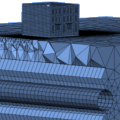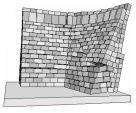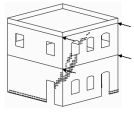|
|
|
0 |
Research Interests
- Earthquake engineering and structural
dynamics
- Assessment and monitoring of existing
infrastructure
- Masonry structures
- Computational modelling
- Soil-structure interaction
|
Research Projects
|
 |
Dynamics
of Rocking Structures
Numerous structures exhibit
rocking behaviour during dynamic
loading, but prediction and control
of the rocking response remains a
challenge. Our research aims to
understand and characterize rocking
motion using analytical dynamics,
and to validate and modelling and
investigate more complex behavior
through computational modelling and
experimental testing. In particular,
the research aims to identify ground
motions to which rocking structures
are most vulnerable, and to improve
methods for predicting rocking
demand, and to design optimized
solutions which utilize rocking
motion. |
 |
Seismic
Response of Masonry Structures
Many masonry structures are
vulnerable to seismic loading. Our
research aims to develop and
evaluate methods for predicting the
seismic response of masonry
structures, particularly to improve
methods of predicting the capacity
of existing structures to resist
collapse. Analytical modelling and
Discrete Element Modelling are used
to predict seismic response, and
experimental testing is used to
evaluate modelling predictions. |
 |
Tunneling-Induced
Structural Damage
Tunnelling causes ground settlement,
which is particularly of concern in
dense urban environments. Our
research uses computational
modelling, centrifuge testing, and
field data to better understand the
interaction between the soil and the
structure, and the resulting
structural damage. The aim is to
improve methods of predicting damage
in order to reduce the costs of
mitigation methods.
|
 |
Assessment
of Historic Structures
Despite their age and prevalence,
the safety of historic stone
structures remains difficult to
assess. This research aims to
improve assessment capabilities, and
involve three primary aspects: 1)
development of new modelling
techniques which focus on structural
stability rather than material
strength, and 2) evaluation and
improvement of Discrete Element
Modelling techniques, and 3)
improved use of laser-scan data for
structural assessment. Applications
have included the assessment of an
ancient Roman Theatre, historic
stone retaining walls, and masonry
arch bridges which are prolific
throughout the UK. |
 |
Computational
Modelling of Brittle Structures
Brittle materials exhibit a
highly nonlinear response due to a
sharp reduction in capacity after
cracking occurs. Our research
involves the development of
simplified methods which use a
series of linear analyses to model
brittle behaviour, providing an
alternative to typical nonlinear
iteration procedures. These methods
are particularly useful for
modelling large-scale structures
where significant energy is released
during cracking. |
|
|